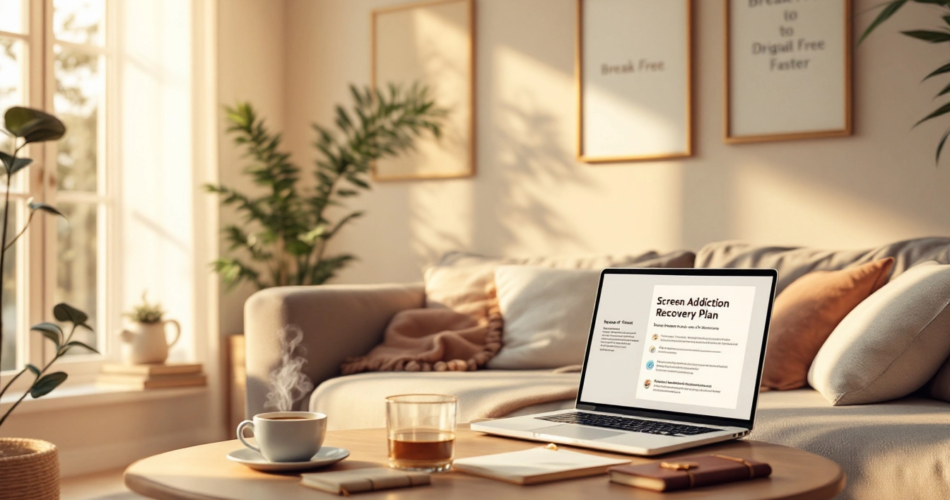In today’s digital age, most of us rely heavily on screens—whether it’s for work, entertainment, or staying connected with loved ones. But what happens when screen time becomes excessive? Research shows that screen addiction is more common than we realize, with alarming rates of dependency affecting people of all ages. Screen addiction can lead to decreased productivity, strained relationships, and even physical health issues like eye strain and poor sleep quality.
Table of Contents
- Understanding Screen Addiction: Why It Happens and Its Impact
- Setting Up Your Screen Addiction Recovery Plan
- Practical Steps to Cut Down Screen Time
- Building Healthy Habits to Replace Screen Time
- Staying Consistent and Overcoming Relapses
- FAQs
Understanding Screen Addiction: Why It Happens and Its Impact
What Is Screen Addiction?
Screen addiction refers to excessive and compulsive use of devices like smartphones, tablets, and computers. Warning signs include spending hours mindlessly scrolling, feeling anxious without your phone, and neglecting offline responsibilities.
The Psychological and Physical Impact of Screen Overuse
Overusing screens can lead to poor sleep, anxiety, and decreased productivity. Studies show that excessive screen time is often linked to mental health challenges like depression and social isolation. For more insights, check out this research on digital addiction.
Why the Time for Change Is Now
The longer screen addiction goes unchecked, the more it can harm your relationships, mental health, and physical well-being. As society continues moving toward greater digital integration, now is the time to regain control of your habits.
Setting Up Your Screen Addiction Recovery Plan
Self-Assessment: Checking Your Screen Usage Habits
Start by tracking your screen time using apps like Moment or Apple’s inbuilt Screen Time tool. Identify times when you’re most prone to excessive use, and pinpoint habits that trigger dependency. Learn more about recognizing digital burnout.
Setting Goals for Recovery and Staying Accountable
Set specific goals, such as “I will reduce my screen time by two hours daily for the next month.” Share your progress with a friend or family for accountability.
Creating an Optimal Environment for Digital Detox
Remove distractions by turning off non-essential notifications and setting devices to “Do Not Disturb.” Establish screen-free zones, such as your dining room or bedroom. Learn more about digital decluttering in this guide.
Practical Steps to Cut Down Screen Time
Time Management Strategies
Plan your day to include designated “offline hours.” Fill these with activities like exercise, reading, or pursuing hobbies.
Using Technology to Beat Technology
Consider apps like Freedom or Forest to block distractions while staying productive. Use features like grayscale mode to make screens less appealing.
Gradual vs. Cold Turkey
Not sure whether to scale back gradually or go all in? Experiment and find an approach that works for your lifestyle and goals.
Building Healthy Habits to Replace Screen Time
Rediscovering Offline Activities
Replace digital use with fun offline options like painting, hiking, or crafting. For weekend plans, explore our screen-free activity ideas.
Strengthening Social Connections
Host in-person get-togethers or take family walks to share meaningful moments without digital distractions.
Practicing Mindfulness
Relieve stress with meditation, journaling, or yoga. For expert techniques, see these mindfulness practices.
Staying Consistent and Overcoming Relapses
Dealing with Slip-Ups
Relapses happen. Instead of being hard on yourself, focus on identifying patterns that lead to excessive screen use.
Tracking and Celebrating Progress
Track progress weekly and celebrate wins like meeting a no-screens-after-dinner goal for a week.
Maintaining a Balanced Digital Life
Adopt habits like biweekly digital detoxes or turning off devices an hour before bed for lasting success.
Frequently Asked Questions
What are the first signs of screen addiction?
Look for behaviors like mindless scrolling, ignoring responsibilities, or feeling irritated without your phone.
How do I start a screen addiction recovery plan?
Begin by examining your habits, setting clear goals, and creating a supportive environment for change.
Are there tools to help limit screen time?
Yes! Apps like RescueTime and Forest can monitor usage and promote mindful habits.
Conclusion
Breaking free from screen addiction takes time, effort, and the right strategies. By applying this screen addiction recovery plan, you can reduce screen dependency and regain control of your life. Start today—you’ll thank yourself later!



Hey there, great post! It was full of useful insights that I enjoyed. Thank you for sharing!
I adore how your prose reflects your distinctive personality. It’s like experiencing an enriching conversation.